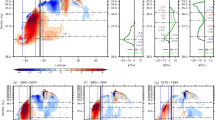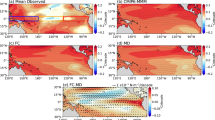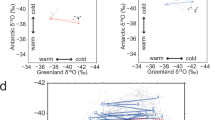Abstract
Decadal temperature fluctuations in the Pacific Ocean have a significant effect on marine ecosystems and the climate of North America. The physical mechanisms responsible for these fluctuations are poorly understood. Some theories ascribe a central role to the wind-driven meridional overturning circulation between the tropical and subtropical oceans. Here we show, from observations over the past 50 years, that this overturning circulation has been slowing down since the 1970s, causing a decrease in upwelling of about 25% in an equatorial strip between 9° N and 9° S. This reduction in equatorial upwelling of relatively cool water, from 47 × 106 to 35 × 106 m3 s-1, is associated with a rise in equatorial sea surface temperatures of about 0.8 °C. Another effect of the slowing circulation is a reduction in the outgassing of CO2 from the equatorial Pacific Ocean–at present the largest oceanic source of carbon dioxide to the atmosphere.
This is a preview of subscription content, access via your institution
Access options
Subscribe to this journal
Receive 51 print issues and online access
$199.00 per year
only $3.90 per issue
Buy this article
- Purchase on Springer Link
- Instant access to full article PDF
Prices may be subject to local taxes which are calculated during checkout



Similar content being viewed by others
References
Minobe, S. Spatio-temporal structure of pentadecadal variability over the North Pacific. Prog. Oceanogr. 47, 381–408 (2000).
Trenberth, K. E. & Hurrell, J. W. Decadal atmosphere-ocean variations in the Pacific. Clim. Dyn. 9, 303–319 (1994).
Mantua, N. J., Hare, S. J., Zhang, Y., Wallace, J. M. & Francis, R. C. A Pacific interdecadal oscillation with impacts on salmon production. Bull. Am. Meteorol. Soc. 76, 1069–1079 (1997).
Zhang, Y., Wallace, J. M. & Battisti, D. S. ENSO-like interdecadal variability: 1900–93. J. Clim. 10, 1004–1020 (1997).
Hare, S. R. & Mantua, N. Empirical evidence for North Pacific regime shifts in 1977 and 1989. Prog. Oceanogr. 47, 103–145 (2000).
Cayan, D. R., Kammerdiener, S. A., Dettinger, M. D., Caprio, J. M. & Peterson, D. H. Changes in the onset of spring in the western United States. Bull. Am. Meteorol. Soc. 82, 399–415 (2001).
Miller, A. J. & Schneider, N. Interdecadal climate regime dynamics in the North Pacific Ocean: theories, observations, and ecosystem impacts. Prog. Oceanogr. 47, 355–379 (2000).
Latif, M. & Barnett, T. P. Cause of decadal variability over the North Pacific and North America: Dynamics and predictability. J. Clim. 9, 2407–2423 (1996).
Lindsey, B. K., Wellington, G. M. & Schrag, D. P. Decadal sea surface temperature variability in the subtropical South Pacific from 1726 to 1997 A. D. Science 290, 1145–1148 (2001).
Garreaud, R. E. & Battisti, D. S. Interannual (ENSO) and interdecadal (ENSO-like) variability in the Southern Hemisphere tropospheric circulation. J. Clim. 12, 2113–2123 (1999).
Gu, D. & Philander, S. G. H. Interdecadal climate fluctuations that depend on exchanges between the tropics and extratropics. Science 275, 805–807 (1997).
Schneider N., Miller, A. J., Alexander, A. & Deser, C. Subduction of decadal North Pacific temperature anomalies: Observations and dynamics. J. Phys. Oceanogr. 29, 1056–1070 (1999).
Schneider, N. et al. Pacific thermocline bridge revisited. Geophys. Res. Lett. 26, 1329–1332 (1999).
Liu, Z. & Shin, S.-I. On thermal ventilation of active and passive tracers. Geophys. Res. Lett. 26, 357–360 (1999).
Nonaka, M., Xie, S.-P. & Takeuchi, K. Equatorward spreading of a passive tracer with application to North Pacific interdecadal temperature variations. J. Oceanogr. 56, 173–183 (2000).
Kleeman, R., McCreary, J. P. & Klinger, B. A mechanism for generating ENSO decadal variability. Geophys. Res. Lett. 26, 1743–1746 (1999).
Johnson, G. C. & McPhaden, M. J. Interior pycnocline flow from the subtropical to the equatorial Pacific Ocean. J. Phys. Oceanogr. 29, 3073–3089 (1999).
Huang, B. & Liu, Z. Pacific subtropical-tropical thermocline water exchange in the National Centers for Environmental Prediction ocean model. J. Geophys. Res. 104, 11065–11076 (1999).
McPhaden, M. J. & Fine, R. A. A dynamical interpretation of the tritium maximum in the central equatorial Pacific. J. Phys. Oceanogr. 18, 1454–1457 (1988).
Quay, P. D., Stuiver, M. & Broecker, W. S. Upwelling rates for the equatorial Pacific Ocean derived from the bomb 14C distribution. J. Mar. Res. 41, 769–792 (1983).
Fine, R. A., Maillet, K. A., Sullivan, K. F. & Willey, D. Circulation and ventilation flux of the Pacific Ocean. J. Geophys. Res. 106, 22159–22178 (2001).
Sverdrup, H. U. Wind-driven currents in a baroclinic ocean: with application to the equatorial currents of the eastern Pacific. Proc. Natl Acad. Sci. USA 33, 318–326 (1947).
Liu, Z. & Huang, B. Cause of tropical Pacific warming trend. Geophys. Res. Lett. 27, 1935–1938 (2000).
Wallace, J. M. et al. On the structure and evolution of ENSO-related climate variability in the tropical Pacific: Lessons from TOGA. J. Geophys. Res. 103, 14241–14259 (1998).
McCreary, J. P. & Lu, P. On the interaction between the subtropical and the equatorial oceans: The subtropical cell. Phys. Oceanogr. 24, 466–497 (1994).
Ralph, E. A. & Niiler, P. P. Wind-driven currents in the tropical Pacific. J. Phys. Oceanogr. 29, 2121–2129 (1999).
Gordon, A. L., Susanto, R. D. & Ffield, A. Throughflow within the Makassar Strait. Geophys. Res. Lett. 26, 3325–3328 (1999).
Philander, S. G. H. Variability of the tropical oceans. Dyn. Atmos. Oceans 3, 191–208 (1979).
Johnson G. C., McPhaden, M. J. & Firing, E. Equatorial Pacific Ocean horizontal velocity, divergence, and upwelling. J. Phys. Oceanogr. 31, 839–849 (2001).
Chavez, F. P. & Toggweiler, J. R. in Upwelling in the Ocean: Modeling Processes and Ancient Records (eds Summerhayes, C. P. et al.) 313–320 (Wiley, New York, 1995).
Wyrtki, K. An estimate of equatorial upwelling in the Pacific. J. Phys. Oceanogr. 11, 1205–1214 (1981).
Meinen, C. S., McPhaden, M. J. & Johnson, G. C. Vertical velocities and transports in the equatorial Pacific during 1993–1999. J. Phys. Oceanogr. 31, 3230–3248 (2001).
Guilderson, T. P. & Schrag, D. P. Abrupt shift in subsurface temperatures in the tropical Pacific associated with changes in El Niño. Science 281, 240–243 (1998).
Chang, P., Giese, B. S., Ji, L., Seidel, H. F. & Wang, F. Decadal change in the south tropical Pacific in a global assimilation analysis. Geophys. Res. Lett. 28, 3461–3464 (2001).
Knutsen, T. R. & Manabe, S. Model assessment of decadal variability and trends in the tropical Pacific Ocean. J. Clim. 11, 2273–2296 (1998).
Federov, A. V. & Philander, S. G. H. Is El Niño changing? Science 288, 1997–2001 (2000).
Urban, F. E., Cole, J. E. & Overpeck, J. T. Influence of mean climate change on climate variability from a 155-year tropical Pacific coral record. Nature 407, 898–993 (2000).
Kirtman, B. P. & Schopf, P. S. Decadal variability in ENSO predictability and prediction. J. Clim. 11, 2843–2822 (1998).
Meehl, G. A. & Washington, W. M. El Niño-like climate change in a model with increased CO2 concentrations. Nature 382, 56–60 (1995).
Feely, R. A., Wanninkhof, R., Takahashi, T. & Tans, P. Influence of El Niño on the equatorial Pacific contribution to atmospheric CO2 accumulation. Nature 398, 597–601 (1999).
Feely, R. A. et al. Seasonal and interannual variability of CO2 in the equatorial Pacific. Deep-Sea Res. (in the press).
Conkright, M. E. et al. World Ocean Database 1998 Version 2.0 (National Oceanographic Data Center Internal Report 14, National Oceanic and Atmospheric Administration, Silver Spring, Maryland, 1999).
da Silva, A. M., Young, C. C. & Levitus, S. Atlas of Surface Marine Data Vol. 1, Algorithms and Procedures (NOAA Atlas NESDIS 6, US Dept. of Commerce, Washington DC, 1994).
Goldenberg, S. B. & O'Brien, J. J. Time and space variability of tropical Pacific wind stress. Mon. Weath. Rev. 109, 1190–1207 (1981).
Kalnay, E. et al. The NCEP/NCAR 40-year reanalysis project. Bull. Am. Meteorol. Soc. 77, 437–471 (1996).
European Centre for Medium-Range Weather Forecasts – ECMWF Data Archive (http://www.ecmwf.int/services/data/archive/) (February 2001).
Hackert, E. C., Busalacchi, A. J. & Murtugudde, R. A. A wind comparison study using an ocean general circulation model for the 1997–98 El Niño. J. Geophys. Res. 106, 2345–2362 (2001).
Godfrey, J. S. A Sverdrup model of the depth-integrated flow for the World Ocean allowing for island circulations. Geophys. Astrophys. Fluid Dyn. 45, 89–112 (1989).
Schneider, N. The Indonesian throughflow and the global climate system. J. Clim. 11, 676–689 (1998).
Smith, T. M., Reynolds, R. W. & Ropelewski, C. F. Optimal averaging of seasonal sea surface temperatures and associated confidence intervals. J. Clim. 7, 949–964 (1994).
Acknowledgements
We thank J. Potemra for advice on Indonesian throughflow calculations. We also thank W. Kessler, G. Johnson and R. Kleeman for comments on an earlier version of this manuscript. This work was supported by the NOAA Office of Oceanic and Atmospheric Research and by the Joint Study for the Atmosphere and Ocean (JISAO) at the University of Washington.
Author information
Authors and Affiliations
Corresponding author
Rights and permissions
About this article
Cite this article
McPhaden, M., Zhang, D. Slowdown of the meridional overturning circulation in the upper Pacific Ocean. Nature 415, 603–608 (2002). https://doi.org/10.1038/415603a
Received:
Accepted:
Issue Date:
DOI: https://doi.org/10.1038/415603a
This article is cited by
-
Variability of the Pacific subtropical cells under global warming in CMIP6 models
Journal of Oceanology and Limnology (2024)
-
Future changes in atmospheric synoptic variability slow down ocean circulation and decrease primary productivity in the tropical Pacific Ocean
npj Climate and Atmospheric Science (2023)
-
Increased tropical South Pacific western boundary current transport over the past century
Nature Geoscience (2023)
-
The interannual variability of shallow meridional overturning circulation and its association with the south-west Indian Ocean heat content variability
Theoretical and Applied Climatology (2023)
-
An assessment of the subduction rate in the CMIP6 historical experiment
Acta Oceanologica Sinica (2023)
Comments
By submitting a comment you agree to abide by our Terms and Community Guidelines. If you find something abusive or that does not comply with our terms or guidelines please flag it as inappropriate.



